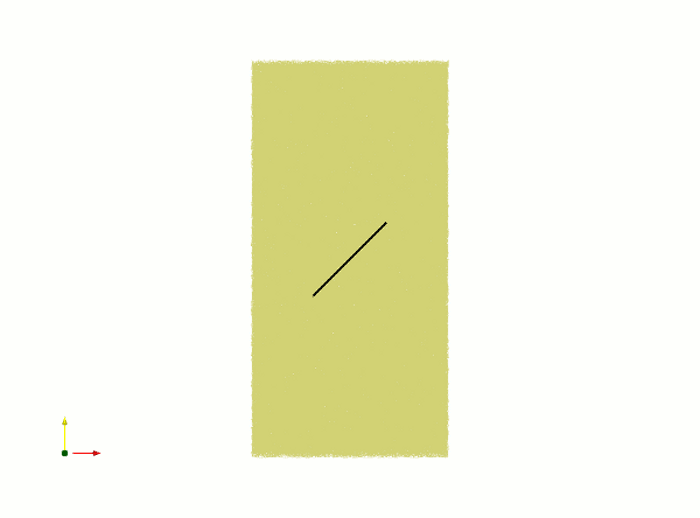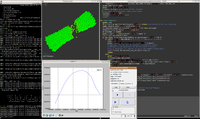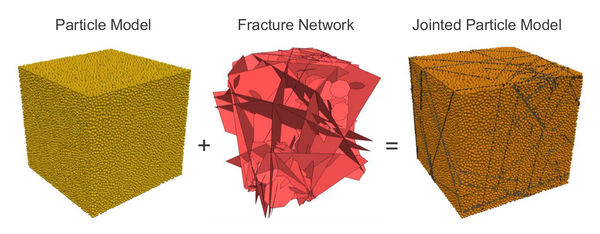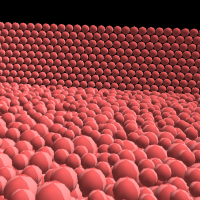Difference between revisions of "Screenshots and videos"
From Yade
| Line 10: | Line 10: | ||
{{#evp:youtube|fyKqaqjx1uQ}}{{#evp:youtube|x4AGNc6hxAY}} |
{{#evp:youtube|fyKqaqjx1uQ}}{{#evp:youtube|x4AGNc6hxAY}} |
||
| − | <youtube>fyKqaqjx1uQ</youtube><youtube>x4AGNc6hxAY</youtube> |
||
(Left) Simulation of a granular outflow from rectangular hopper. You can see the funnel and wall layer. (Right) Outflow of frictionless particles from rectangular hopper. Color denotes a local free volume. Seen an increase in free volume in the regions of shear flow due to the effect of dilatancy. |
(Left) Simulation of a granular outflow from rectangular hopper. You can see the funnel and wall layer. (Right) Outflow of frictionless particles from rectangular hopper. Color denotes a local free volume. Seen an increase in free volume in the regions of shear flow due to the effect of dilatancy. |
||
Revision as of 14:20, 18 July 2014
If you are working with yade, please upload some of your screenshots to show others your work!
Videos
If videos are not displayed, it may be due to the security options of your web browser.
If you are using Mozilla Firefox, click the shield icon on the left of the address bar and choose "Disable Protection on this Page" from the dropdown menu.
Rectangular outflow
(Left) Simulation of a granular outflow from rectangular hopper. You can see the funnel and wall layer. (Right) Outflow of frictionless particles from rectangular hopper. Color denotes a local free volume. Seen an increase in free volume in the regions of shear flow due to the effect of dilatancy.
Rectangular outflow: frictional VS frictionless walls
Simulation of a granular outflow from rectangular hopper. Front and back walls is frictional (right two) and frictionless (left two). You can see different flows pattern.
Cylinder outflow: flat bottom
Simulation of a granular outflow from a cylindrical hopper with flat bottom. On the right hand side, particles are colored by local volume of solid. You can see the rarefaction in the shear flow region at bottom of the cylinder due to dilatancy.
Cylinder outflow: conical bottom and jamming
(Left) Simulation of a granular outflow from a cylindrical hopper with conical bottom. (Right) How granular materials jam in a hopper. The simulation is inspired by experimental work of J.Tang and R.P. Behringer http://youtu.be/lWSJwZhqoQw
Ball Mill 2
(Left) A sample of simulation of movement of 125 000 spheres with YADE. This simulation take 14h30m for 50 000 iterations on laptop with Intel(R) Core(TM)2 Duo CPU T8100 @ 2.10GHz processor and 2GB memory. So, perfomance was 0.95 iter/sec.
See yade script here (it need this stl-file for the mill shape.)
(Right)
See yade script. The mill shape is constructed parametrically from within the script itself.
Surface triangulation and filling
Sphere packing (regular) is generated to fit inside the horse-shaped triangulated surface (imported from file). The same horse is the used underneath, on which the spheres fall from above. Script is here
Representing beams, wires, grids, with connected cylinders
Connected cylinders with rounded ends (alternatively seen as Minkowski sum of a polyline and a sphere) enables simulation of wires or rods interacting with particles, with a smooth interface. On the left-hand side (top), a spring represented by connected cylinders (this script), the end of the spring is dragged away with the mouse in the middle of the simulation, then released. On the right-hand side, the simulation defined in this script. The last videos shows how the cylinders can be used to modelize nets.
Modelling wires and meshes with remote interactions
Simulation of an impact on a horizontal spanned double-twisted hexagonal wire mesh, as used in rockfall protection, with remote interactions (Thoeni et al. 2013). Example scripts are provided here.
Solid-fluid coupling
A new method for efficiently coupling the DEM with fluid flow is being developed as part of Yade. The development started as part of Emanuele Catalano's PhD (Chareyre et al. 2011), and later included other developments.
The first video is the simulation of an injection of fluid below a granular bed. The problem is 3D, a cutting plane goes is used near the injection point. Color denotes fluid pressure.
The video on the right shows the flow of particle subjected to gravity and horizontal fluid flow. The periodic boundary conditions for the fluid are implemented by Donia Marzougui (PhD 3SR, Grenoble).
2D Solid-fluid coupling by associating DEM with LBM (lattice Boltzmann method)
The lattice Boltzmann method to describe the fluid dynamics has been coupled with the discrete element method in Yade. The implementation, currently limited to 2D cases, was initiated by Luc Scholtès and further developed by Franck Lominé (Lominé et al. 2013) during their postdoc in GeM Institute (Nantes, France).
The first video show the free fall of two particles in a fluid initially at rest (i.e. the fluid motion is induced by the particle displacements). The second video show an application of the coupled method to study the hole erosion in granular assemblies (a pressure drop is applied to the fluid from the left to the right, and particles are detached and transported under the action of the fluid flow).
Model of a wet sand with rising water table
With the capillary law in Yade it is possible to model a wet sand with capillary forces. During the calculation the liquid bridges break from the bottom to the top (water table visualized by a blue face). This simulates a rising water table. The calculation was performed with multi-threading option on six cores. Hence there is a indeterminism, that entails to non-reproducibility of each calculation. Approximatly 10 percent of the calculations show no settlement (see right side in the video).
Periodic boundary conditions
Generic 3D periodic boundary conditions are implemented in Yade and handle arbitrary velocity fields. In this example a large plate is introduced, de facto restricting the periodicity to two dimensions. This video is generated with the example script periodicSandPile.py
Simulation of some prcessing machines
Screening Machine
Selective Comminution
Screw conveyor
Impact crusher
Ball Mill
Modelling progressive failure in rocks
Uniaxial compression test simulation of a synthetic rock like material containing a pre-existing flaw/fracture. Wing cracks initiate at the tip of the disconitnuity and propagate according to the stress field until complete failure of the sample as a result of the coalescence of interparticle microcracks (interparticle bonds breakage).
Screenshots
Uniaxial tension/compression test
This example can be found in examples/concrete/uniax.py
Jointed/Fractured Media
YADE can be used to model media containing pre-existing fractures/discontinuities. The module was initially developed for the study of fractured rock masses as described in refs [1], [2] and [3].
Discrete fracture network (DFN) can be imported as meshed surfaces and embeded into a predefined intact medium consisting of bonded particles. Interactions located across a discontinuity surface are identified and their behavior can be adjusted according to the user's choice (cohesive, frictional,...). An option provides the possibility to orientate the contact geometry in agreement with the discontinuity surface to get rid of the particle shape (for more details, see refs [1], [2] and [3]). An example showing how to use this module is provided in example/jointedCohesiveFrictionalPM/
[1] http://dx.doi.org/10.1016/j.jmps.2011.01.009
[2] http://dx.doi.org/10.1016/j.ijrmms.2012.02.009
[3] http://dx.doi.org/10.1111/j.1365-246X.2012.05642.x
Other
Yade is now (2007) good enough to produce some results. Those results are at first compared with results from other numerical computations software, then with real-world experiments. Several articles are planned to be written about it. For now you can have a short glance at what kind of results we can produce so far. Bear in mind that this is just a quick look at screenshots and nothing more.



